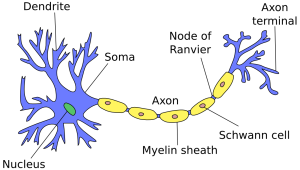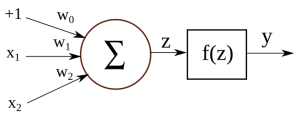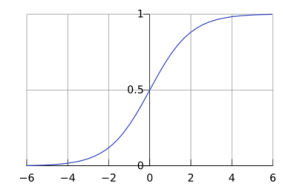NEURAL NETWORKS, PART 2: THE NEURON
NEURAL NETWORKS, PART 2: THE NEURON
A neuron is a very basic classifier. It takes a number of input signals (a feature vector) and outputs a single value (a prediction). A neuron is also a basic building block of neural networks, and by combining together many neurons we can build systems that are capable of learning very complicated patterns. This is part 2 of an introductory series on neural networks. If you haven’t done so yet, you might want to start by learning about the background to neural networks in part 1.
Neurons in artificial neural networks are inspired by biological neurons in nervous systems (shown below). A biological neuron has three main parts: the main body (also known as the soma), dendrites and an axon. There are often many dendrites attached to a neuron body, but only one axon, which can be up to a meter long. In most cases (although there are exceptions), the neuron receives input signals from dendrites, and then outputs its own signals through the axon. Axons in turn connect to the dendrites of other neurons, using special connections called synapses, forming complex neural networks.
 Figure 1: Biological neuron in a nervous system
Figure 1: Biological neuron in a nervous system
Below is an illustration of an artificial neuron, where the input is passed in from the left and the prediction comes out from the right. Each input position has a specific weight in the neuron, and they determine what output to give, given a specific input vector. For example, a neuron could be trained to detect cities. We can then take the vector for London from the previous section, give it as input to our neuron, and it will tell us it’s a city by outputting value 1. If we do the same for the word Tuesday, it will give a 0 instead, meaning that it’s not a city.
 Figure 2: Artificial neuron
Figure 2: Artificial neuron
You might notice that there’s a constant value of +1 as one of the input signals, and it has a separate weight w0. This is called a bias, and it allows the network to shift the activation function up or down. Biases are not strictly required for building neurons or neural networks, but they can be very important to the performance, depending on the types of feature values you are using.
Let’s say we have an input vector [1,x1,x2] and a weight vector [w0,w1,w2]. Internally, we first multiply the corresponding input values with their weights, and add them together:
z=(w0×1)+(w1×x1)+(w2×x2)
Then, we pass the sum through an activation function. In this case we will use the sigmoid function (also known as the logistic curve) as our activation function.
y=f(z)=f((w0×1)+(w1×x1)+(w2×x2))
where
f(t)=11+e−t
The sigmoid function takes any real value and maps it to a range between 0 and 1. When plotted, a sigmoid function looks like this:
 Figure 3: Sigmoid function
Figure 3: Sigmoid function
Using a sigmoid as our activation function has some benefits:
- Regardless of input, it will map everything to a range between 0 and 1. We don’t have to worry about output values exploding for unexpected input vectors.
- The function is non-linear, which allows us to learn more complicated non-linear relationships in our neural networks.
- It is differentiable, which comes in handy when we try to perform backpropagation to train our neural networks.
However, it is not required to use an activation function, and there exist many successful network architectures that don’t use one. We could also use a different activation, such as a hyperbolic tangent or a rectifier.
We have now looked at all the components of a neuron, but we’re not going to stop here. Richard Feynman once said “What I cannot create, I do not understand”, so let us create a working example of a neuron. Here is the complete code required to test a neuron with pre-trained weights:
|
1
2
3
4
5
6
7
8
9
10
11
12
13
14
15
16
17
18
19
20
21
22
23
24
25
26
27
28
29
30
31
32
33
34
35
36
37
38
39
40
41
42
43
44
45
46
47
48
49
50
51
52
53
54
55
56
57
|
public class SimpleNeuron { private double[] weights; public SimpleNeuron(double[] weights){ this.weights = weights; } public double classify(double[] input){ double value = 0.0; // Adding the bias value += weights[0] * 1.0; // Adding the rest of the weights for(int i = 0; i < input.length; i++) value += weights[i + 1] * input[i]; // Passing the value through the sigmoid activation function value = 1.0 / (1.0 + Math.exp(-1.0 * value)); return value; } public static void main(String[] args) { // Creating data structures to hold the data String[] names = new String[5]; double[][] vectors = new double[5][2]; // Inserting the data names[0] = "London"; vectors[0][0] = 0.86; vectors[0][1] = 0.09; names[1] = "Paris"; vectors[1][0] = 0.74; vectors[1][1] = 0.11; names[2] = "Tuesday"; vectors[2][0] = 0.15; vectors[2][1] = 0.77; names[3] = "Friday"; vectors[3][0] = 0.05; vectors[3][1] = 0.82; names[4] = "???"; vectors[4][0] = 0.59; vectors[4][1] = 0.19; // Initialising the weights double[] weights = {0.0, 100.0, -100.0}; SimpleNeuron neuron = new SimpleNeuron(weights); // Classifying each of the data points for(int i = 0; i < names.length; i++){ double prediction = neuron.classify(vectors[i]); System.out.println(names[i] + " : " + (int)prediction); } }} |
The classify() function is the interesting part in this code. It takes a feature vector as an argument and returns the prediction value y. For testing, we use the examples from the previous section and try to classify each of them. The output of running this code will be as follows:
|
1
2
3
4
5
|
London : 1Paris : 1Tuesday : 0Friday : 0??? : 1 |
As you can see, the neuron has successfully separated cities from days. It has also provided a label for the previously-unknown example – apparently the last data point should belong with cities as well.
For this code example, I manually chose and hard-coded weight values, so that it would provide a good classification. In later sections we will see how to have the system learn these values automatically, using some training data.
Now that we know about individual neurons, in the next section we’ll look at how to connect them together and form neural networks.
NEURAL NETWORKS, PART 2: THE NEURON的更多相关文章
- 【转】Artificial Neurons and Single-Layer Neural Networks
原文:written by Sebastian Raschka on March 14, 2015 中文版译文:伯乐在线 - atmanic 翻译,toolate 校稿 This article of ...
- [转]Neural Networks, Manifolds, and Topology
colah's blog Blog About Contact Neural Networks, Manifolds, and Topology Posted on April 6, 2014 top ...
- A Beginner's Guide To Understanding Convolutional Neural Networks(转)
A Beginner's Guide To Understanding Convolutional Neural Networks Introduction Convolutional neural ...
- [CS231n-CNN] Training Neural Networks Part 1 : activation functions, weight initialization, gradient flow, batch normalization | babysitting the learning process, hyperparameter optimization
课程主页:http://cs231n.stanford.edu/ Introduction to neural networks -Training Neural Network ________ ...
- Hacker's guide to Neural Networks
Hacker's guide to Neural Networks Hi there, I'm a CS PhD student at Stanford. I've worked on Deep Le ...
- ON THE EVOLUTION OF MACHINE LEARNING: FROM LINEAR MODELS TO NEURAL NETWORKS
ON THE EVOLUTION OF MACHINE LEARNING: FROM LINEAR MODELS TO NEURAL NETWORKS We recently interviewed ...
- Stanford机器学习---第五讲. 神经网络的学习 Neural Networks learning
原文 http://blog.csdn.net/abcjennifer/article/details/7758797 本栏目(Machine learning)包括单参数的线性回归.多参数的线性回归 ...
- 深度学习笔记(三 )Constitutional Neural Networks
一. 预备知识 包括 Linear Regression, Logistic Regression和 Multi-Layer Neural Network.参考 http://ufldl.stanfo ...
- 提高神经网络的学习方式Improving the way neural networks learn
When a golf player is first learning to play golf, they usually spend most of their time developing ...
随机推荐
- web安全培训笔记
1.漏洞获取方法 1)扫描器扫描 2)乌云 3)线上服务漏洞 样例: 线上crm->管理员弱口令->后台上传头像处漏洞->上传php文件->进入内网->扫描内网拓扑-&g ...
- PCAP 抓包
PCAP是一个数据包抓取库, 很多软件都是用它来作为数据包抓取工具的. WireShark也是用PCAP库来抓取数据包的.PCAP抓取出来的数据包并不是原始的网络字节流,而是对其进行从新组装,形成一种 ...
- iOS中保证线程安全的几种方式与性能对比
来源:景铭巴巴 链接:http://www.jianshu.com/p/938d68ed832c 一.前言 前段时间看了几个开源项目,发现他们保持线程同步的方式各不相同,有@synchronized. ...
- SQL语句中"where 1=1"和"where 1=0"的作用
where 1=1; 这个条件始终为True,在不定数量查询条件情况下,1=1可以很方便的规范语句. 一.不用where 1=1 在多条件查询中的困扰 举个例子,如果您做查询页面,并且,可查询的选项有 ...
- FAQs: 我们可以在那里来为我的没有提升管理权限的应用程序存储用户数据?
如果你正在写一个不需要管理员权限的应用程序,如写一个业务线应用(Line of Business,LOB),用户应用程序如游戏,你总是要把应用程序的数据写到一个标准用可以访问的目录.下面列出一些所推荐 ...
- 使用gradle构建java项目
gradle是什么东东 gradle是继ant,maven之后另外一种的面向java的自动化项目构建工具,他是基于groovy语言的.相对于ant,maven,gradle显得更加简单. 安装grad ...
- api图片传输,转成64位字符串进行传输
byte[] getImageByte = HttpHelper.getImageByte(HttpContext.Current.Server.MapPath(("~/UploadFile ...
- css标准导航代码
<!-- 例子解析: --> --> <!-- list-style-type:none - 移除列表前小标志.一个导航栏并不需要列表标记 --> <!-- 移除浏 ...
- C#中的委托范例学习
using System; using System.Collections.Generic; using System.Linq; using System.Text; namespace Cons ...
- js EasyUI前台 全选的实现
aaarticlea/png;base64,iVBORw0KGgoAAAANSUhEUgAAAWcAAAEQCAIAAADj/SKjAAAgAElEQVR4nO1dz48ry1W+/5N3swaFEP ...
